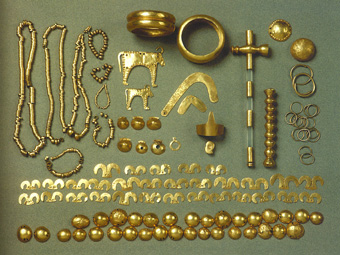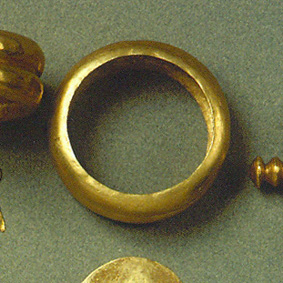Ancient Goldsmiths
The metal of choice for a goldsmith is gold. It is not to say that other metals are not used from time to time, but gold plays the dominant role in the goldsmithing. The earliest known gold artifacts are from a burial site known as Varna Necropolis, Bulgaria. They were dated to 5-th millennia B.C.
 I was able to locate photo of the artifacts on the Internet. I wish I could give proper credit to whoever took the photo, but it was put on the Internet without any identification. If someone knows the name of the photographer, I would gladly update this text with the proper attribution.
I was able to locate photo of the artifacts on the Internet. I wish I could give proper credit to whoever took the photo, but it was put on the Internet without any identification. If someone knows the name of the photographer, I would gladly update this text with the proper attribution.
The technical sophistication, displayed by these artifacts, is absolutely amazing. Take a look at hollow bangle. What a magnificent example of anticlastic raising. Even in modern shop, it is not a trivial task to create bangle like it. One cannot help but wonder how could ancient goldsmiths know so much about working with gold.
Let’s look at the task of creating such bangle in 5-th millennia B.C. It is not likely that Hoover and Strong were around at that time, so a goldsmith had to procure his own gold. Since hammering gold into shape requires metal uniformity, the gold found in natural state had to be smelted. The gold ingot so obtained, was converted into sheet by hammering it. Pure gold does not require annealing, but gold alloy does. It is doubtful that ancient goldsmiths could refine gold to the degree of purity where annealing would be unnecessary, so they had to know how to anneal the gold to remove the work hardening.
 After gold sheet was hammered out, it was cut to required length and width, and soldered to create a hoop. While act of cutting is a simple process in the modern shop, it was far from simple in those times. Soldering was probably done on bed of coals, which was quite a feat in itself. Use of solder implied knowledge of alloys and varying melting points depending on alloy composition. This is almost too much to believe that such knowledge could exist 7000 years ago. But the shape of the bangle is the most remarkable feature of all. To get to the required shape it is necessary to compress metal at the edges to compensate for the difference in length along the bangle profile. Mathematically speaking, the surface of the bangle mimics the surface of a toroid. If we measure the circumference of the bangle in the highest point of it’s convex, and compare to the circumference at the edges, there would be a significant difference in length. A goldsmith must be keenly aware of that difference and compensate for it by well planned and well placed strikes of a hammer.
After gold sheet was hammered out, it was cut to required length and width, and soldered to create a hoop. While act of cutting is a simple process in the modern shop, it was far from simple in those times. Soldering was probably done on bed of coals, which was quite a feat in itself. Use of solder implied knowledge of alloys and varying melting points depending on alloy composition. This is almost too much to believe that such knowledge could exist 7000 years ago. But the shape of the bangle is the most remarkable feature of all. To get to the required shape it is necessary to compress metal at the edges to compensate for the difference in length along the bangle profile. Mathematically speaking, the surface of the bangle mimics the surface of a toroid. If we measure the circumference of the bangle in the highest point of it’s convex, and compare to the circumference at the edges, there would be a significant difference in length. A goldsmith must be keenly aware of that difference and compensate for it by well planned and well placed strikes of a hammer.
Could the ancient goldsmiths understood toroid shape to such a degree that they could manipulate an annulus constructed of flat metal strip to assume toroidal shape. As improbable as it is, it is hard not to come to that conclusion.
Let’s forward the tape 7000 years and look at modern jewellery shop. It is highly unlikely to find a modern goldsmith swinging a hammer at a gold ingot. Casting replaced hand fabrication. Wax carving made the skill of shaping gold obsolete. Goldsmith is no longer required to come up with ingenuous solutions to difficult soldering problems, since lasers can produce tiny welds with impunity.
We have discarded the knowledge bequeathed to us by the Ancient Goldsmiths for the sake of convenience. Except for the very few, the term goldsmith has lost it’s meaning and gold worker is far more appropriate. Some call it a progress, but there are others who disagree.
Out of reservoir of knowledge, accumulated by Ancient Goldsmiths, disciplines like Metallurgy, Chemistry, Applied Mathematics, and many others were born. An ancient goldsmith, toiling over his forge, was the principal seed out of which our civilization has grown.
The role of modern goldsmith if far more humble, and the golden age of goldsmithing has past. Going forward, I wonder. What is the function of a goldsmith in the 21-rst century? Are we ever going to assume the role of pioneers of Science and Technology like the Ancient Goldsmiths did, instead of been just users of inventions by others? What is the function of Jewellery in modern society? I would love to know your thoughts on the subject.
Leonid Surpin
leonidsurpin
Latest posts by leonidsurpin (see all)
- Introduction to CAD - May 26, 2011
- Influence of Poison on Silverware Design - March 6, 2010
- Eternity Ring DVD Guide - March 1, 2010

{ 6 comments… read them below or add one }
As to your amazement at how 7000 years ago people could have the knowledge they did – for doing ANYTHING – there is a God and in the Bible it tells us that HE did endow peoploe with knowledge of the various crafts needed to conduct HIS business here on earth.
There never has been any ‘mystery’.
with all due respect calvin smith,
i believe you may find ‘reaction soldering with copper on an early medieval disc brooch from germany’ by christoph j raub somewhat enlightening
Can you please explain me what is “riposo” and “dyforming” may be my spelling is wrong. these are two methods for goldsmithing.
Thanking you in advance,
Dvora
Leonard
I am as well as a jeweller I am certified archaeologist and originally I come from the city of York which was both a Roman and a Viking city. The museum there has a wealth of ancient jewellery and I often look and marval at the skills that our forerunners had. I don’t know which interest, the jewellery or the archaeology led to which – both are a passion.
I don’t cast I only fabricate and that is what I teach to my students. I was pleased a few weeks ago when my mechanic son who has a great respect for tools asked me to teach him to be a jeweller.
I recently was doing some family history research and have found that a direct decendant of mine was a freeman coppersmith in York in 1684 and another was a printing plate engraver in the early 1800’s so maybe its in the genes hope so?
Regarding the loss of traditional skills as long as there are James Miller’s and Leonard Surpins et al around, the traditional skills of the jeweller will not die as your work encourages others to follow that path.
With all due respect Leonid, unless you see some evidence of soldering that I don’t, I wouldn’t assume that the ancient goldsmith knew how to solder. The bangle could have been joined by hammer welding. It also could have been formed by forging with no joint at all.
Lets also consider that smelting would not be necessary. Natural gold nuggets are pure enough to use with no refining and they could be joined together into larger pieces by hammer welding. Making an ingot would not be necessary.
We have tools that were not available to this ancient goldsmith. Perhaps this encourages us to think of complex answers when the ancients used to do it in a simpler way.
Leonid, excellent rendition telling the history of goldsmithing, and for that matter all smithing. Hopefully, and I do mean hopefully, the craft will not die and go the way of the dinosaurs. The skill and vision in creating designs for various styles of jewelry will never be recreated by a calculating machine (robot). However, I see the youth of today as wanting instant gratification, instant solutions, and instant life (blogs, ipods, internet for everything). At times, I see my youngest (21 years old) actually surprise me and want something that is ascetic and innately beautiful. That gives me some hope for the future.